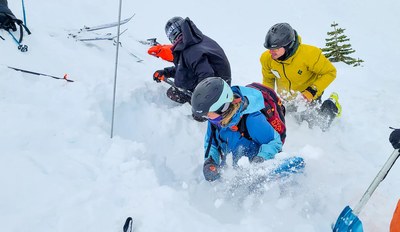
Field trip: Winter Trip Planning - Basic Backcountry Preparedness
Intro to Avalanche Rescue - Snoqualmie Summit Ski Areas
3-to-4-hour activity to introduce the participants to avalanche beacon, shovel and probe to understand the basic principles of avalanche rescue.
- Sun, Feb 18, 2024
- Seattle Snowshoeing Committee
- Avalanche Safety
- Beginner
- Adults
- Casual
- Elevation Gain: 800 ft
- 9 (9 capacity)
- 3 (3 capacity)
- Fri, Feb 3, 2023 at 10:31 PM
- Fri, Feb 16, 2024 at 5:00 PM
- Cancellation & Refund Policy
- iCal Google
There are currently no restrictions in place. Masks are optional.
We encourage participants to carpool, as parking can be limited. We do not facilitate carpooling, however, the pre-trip email will include information on ways participants may arrange carpooling amongst yourselves.
CLINIC OUTLINE:
- Before the trip, logistics will be shared in an email, about 5 days in advance.
- On the morning of the trip, the group will come together and discuss the plan for the day, check their gear, and start traveling.
- Once we arrive at the most suitable terrain, we practice rescue drills (fine search including bracketing, course search, shoveling techniques, and full scenario)
- At the end of the trip, the group will get together to debrief the actions and decisions for the day.
THIS CLINIC DOES NOT REPLACE AIARE'S LEVEL-1 OR AVALANCHE RESCUE COURSE.
Before signing up for this clinic please be sure you have access to a winter-capable vehicle.
TBD
Snoqualmie Summit Ski Areas
-
Green Trails Snoqualmie Pass No. 207
Green Trails Snoqualmie Pass Gateway No. 207S
USGS Snoqualmie Pass - See full route/place details.
Required Equipment
REQUIRED EQUIPMENT
Every person's clothing needs are different. Some people get colder more quickly than others. Remember NO COTTON.
If you don't have any of this gear, try borrowing it from friends before you purchase it.
You must bring the Ten Essentials and Clothing & Equipment for the field trip.
TEN ESSENTIALS: Map (provided to you in digital format), compass, sunglasses and sunscreen, extra clothing, emergency shelter, headlamp/flashlight, first-aid supplies, fire starter, matches, knife, extra food & water. Sun protection is a must. Snow reflection is highly damaging to the eyes; UV damage and sunburns are common if proper protection is not used.
CLOTHING & EQUIPMENT
- Pack (large enough for all winter gear)
- Snowshoes
- Ski Poles/Trekking poles with baskets
- Sturdy, lug-soled, waterproofed boots
- Clothing Layers
AVALANCHE RESCUE GEAR
- Avalanche Beacon
- Metal Shovel
- Avalanche Probe
Inner Layer:
- Wicking Liner socks, 2 pairs (one pair worn, other pair carried)
- Synthetic Warm Underwear, top & bottom, 2 sets (one set worn, other set carried)
- Liner gloves, (+extra set in the pack)
Insulating Layer:
- Outer socks, 2 pairs (one pair worn, other pair carried)
- Pants, synthetic fleece, or wool. Soft-shell or sturdy hiking pants suffice for many.
- Shirt or sweater, synthetic fleece or wool
- Mittens or gloves, 2 pairs (one pair worn, other pair carried)
Protective Layer:
- Rain parka with hood – waterproof & breathable preferred; remember, coated nylon doesn’t breathe and traps moisture under the clothing.
- Rain pants – waterproof & breathable preferred to avoid trapped moisture.
- Long gaiters. Be sure they fit your boots correctly so that snow doesn’t crawl underneath. GoreTex or insulated gaiters are not necessary.
- Hats (one for warmth; one for sun protection).
- Wind jacket (which may be your rain parka). A fleece or wind stopper vest is also handy if it is warm.
- Scarf or neck gaiter if you tend to get cold easily.
Additional Recommended Equipment/Supplies for the Field Trip:
- Foam sit pad
- Hand and toe warmers
- Toilet paper, sealable plastic bags, and hand sanitizer
- Pack cover
- Dry clothes and shoes in your car for the trip home
- Garbage bags in your car for wet gear
- Camera and extra batteries, if desired
